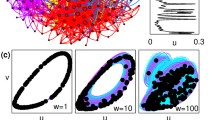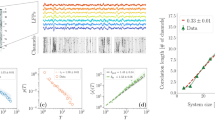Abstract
It has been considered that the state in the vicinity of a critical point, which is the point between ordered and disordered states, can underlie and facilitate information processing of the brain in various aspects. In this research, we numerically study the influence of criticality on one aspect of brain information processing, i.e., the community structure, which is an important characteristic of complex networks. We examine community structure of the functional connectivity in simulated brain spontaneous activity, which is based on dynamical correlations between neural activity patterns at different positions. The brain spontaneous activity is simulated by a neural field model whose parameter covers subcritical, critical, and supercritical regions. Then, the corresponding dynamical correlation patterns and community structure are compared. In the critical region, we found some distinctive properties, namely high correlation and correlation switching, high modularity and a low number of modules, high stability of the dynamical functional connectivity, and moderate flexibility of the community structure across temporal scales. We also discuss how these characteristics might improve information processing of the brain.










Similar content being viewed by others
References
Amari S (1977) Dynamics of pattern formation in lateral-inhibition type neural fields. Biol Cybern 27(2):77–87
Baliki MN, Geha PY, Apkarian AV, Chialvo DR (2008) Beyond feeling: chronic pain hurts the brain, disrupting the default-mode network dynamics. J Neurosci 28(6):1398–1403
Bassett DS, Wymbs NF, Porter MA, Mucha PJ, Carlson JM, Grafton ST (2011) Dynamic reconfiguration of human brain networks during learning. Proc Natl Acad Sci USA 108(18):7641–7646
Beggs JM (2008) The critical hypothesis: how local cortical networks might optimize information processing. Philos Trans R Soc A 336:329–343
Beggs JM, Plenz D (2003) Neuronal avalanches in neocortical circuits. J Neurosci 23(35):11167–11177
Benayoun M, Cowan JD, van Drongelen W, Wallace E (2010) Avalanches in a stochastic model of spiking neurons. PLoS Comput Biol 6(7):e1000846
Bertschinger N, Natschläger T (2004) Real-time computation at the edge of chaos in recurrent neural networks. Neural Comput 16(7):1413–1436
Biswal B, Yetkin F, Haughton V, Hyde J (1995) Functional connectivity in the motor cortex of resting human brain using echo-planar MRI. Magn Reson Med 34(4):537–541
Blondel VD, Guillaume J-L, Lambiotte R, Lefebvre E (2008) Fast unfolding of communities in large networks. J Stat Mech Theor Exp 2008(10):P10008
Bullmore E, Sporns O (2009) Complex brain networks: graph theoretical analysis of structural and functional systems. Nat Rev Neurosci 10:186–198
Chang C, Glover GH (2010) Time-frequency dynamics of resting-state brain connectivity measured with fMRI. Neuroimage 50(1):81–98
Chialvo DR, Balenzuela P, Fraiman D (2008) The brain: what is critical about it?. AIP Conf Proc 1028:28–45
Chow CC, Coombes S (2006) Existence and wandering of bumps in a spiking neural network model. SIAM J Appl Dyn Syst 5(4):552–574
Cordes D, Haughton VM, Arfanakis K, Carew JD, Turski PA, Moritz CH, Quigley MA, Meyerand ME (2001) Frequencies contributing to functional connectivity in the cerebral cortex in resting-state data. Am J Neuroradiol 22:1326–1333
de Arcangelis L, Herrmann HJ (2010) Learning as a phenomenon occurring in a critical state. Proc Natl Acad Sci USA 107(9):3977–3981
Ermentrout GB, Cowan JD (1979) A mathematical theory of visual hallucination patterns. Biol Cybern 34(3):137–150
Fenn DJ, Porter MA, McDonald M, Williams S, Johnson NF, Jones NS (2009) Dynamic communities in multichannel data: an application to the foreign exchange market during the 2007–2008 credit crisis. Chaos 19(3):033119
Ferrarini L, Veer IM, Baerends E, van Tol M-J, Renken RJ, van der Wee NJA, Veltman DJ, Aleman A, Zitman FG, Penninx BWJH, van Buchem MA, Reiber JHC, Rombouts SARB, Milles J (2009) Hierarchical functional modularity in the resting-state human brain. Hum Brain Mapp 30(7):2220–2231
Folias SE, Bressloff PC (2004) Breathing pulses in an excitatory neural network. SIAM J Appl Dyn Syst 3(3):378–407
Fox MD, Raichle ME (2007) Spontaneous fluctuation in brain activity observed with functional magnetic resonance imaging. Nat Rev Neurosci 8(9):700–711
Fox MD, Snyder AZ, Vincent JL, Corbetta M, Van Essen DC, Raichle ME (2005) The human brain is intrinsically organized into dynamic, anticorrelated functional networks. Proc Natl Acad Sci USA 102(27):9673–9678
Freeman WJ, Rogers LJ, Holmes MD, Silbergeld DL (2000) Spatial spectral analysis of human electrocorticograms including the alpha and gamma bands. J Neurosci Methods 95:111–121
Greicius MD, Krasnow B, Reiss AL, Menon V (2003) Functional connectivity in the resting brain: a network analysis of the default mode hypothesis. Proc Natl Acad Sci USA 100(1):253–258
Hahn G, Petermann T, Havenith MN, Yu S, Singer W, Plenz D, Nikolić D (2010) Neuronal avalanches in spontaneous activity in vivo. J Neurophysiol 104(6):3312–3322
Haldeman C, Beggs JM (2005) Critical branching captures activity in living neural networks and maximizes the number of metastable states. Phys Rev Lett 94(5):058101
Hampson M, Peterson BS, Skudlarski P, Gatenby JC, Gore JC (2002) Detection of functional connectivity using temporal correlations in MR images. Hum Brain Mapp 15(4):247–262
Han F, Caporale N, Dan Y (2008) Reverberation of recent visual experience in spontaneous cortical waves. Neuron 60(2):321–327
He Y, Wang J, Wang L, Chen ZJ, Yan C, Yang H, Tang H, Zhu C, Gong Q, Zang Y, Evans AC (2009) Uncovering intrinsic modular organization of spontaneous brain activity in humans. PLoS One 4(4):e5226
Hebb DO (1949) The organization of behavior. Wiley, New York
Henrie JA, Shapley R (2005) LFP power spectra in V1 cortex: the graded effect of stimulus contrast. J Neurophysiol 94:479–490
Honey CJ, Kötter R, Breakspear M, Sporns O (2007) Network structure of cerebral cortex shapes functional connectivity on multiple time scales. Proc Natl Acad Sci USA 104(24):10240–10245
Kinouchi O, Copelli M (2006) Optimal dynamical range of excitable networks at criticality. Nat Phys 2:348–351
Kishimoto K, Amari S (1979) Existence and stability of local excitation in homogeneous neural fields. J Math Biol 7(4):303–318
Klaus A, Yu S, Plenz D (2011) Statistical analyses support power law distributions found in neuronal avalanches. PLoS One 6(5):e19779
Klemm K, Eguíluz VM, Toral R, Miguel MS (2003) Global culture: a noise-induced transition in finite systems. Phys Rev E 67(4):045101(R)
La Camera G, Rauch A, Thurbon D, Lüscher H-R, Senn W, Fusi S (2006) Multiple time scales of temporal response in pyramidal and fast spiking cortical neurons. J Neurophysiol 96(6):3448–3464
Laing CR (2005) Spiral waves in nonlocal equation. SIAM J Appl Dyn Syst 4(3):588–606
Lewis CM, Baldassarre A, Committeri G, Romani GL, Corbetta M (2009) Learning sculpts the spontaneous activity of the resting human brain. Proc Natl Acad Sci USA 106(41):17558–17563
Lowe MJ, Mock BJ, Sorenson JA (1998) Functional connectivity in single and multislice echoplanar imaging using resting-state fluctuations. Neuroimage 7(2):119–132
Lu ET, Hamilton RJ (1991) Avalanches and the distribution of solar flares. Astrophys J 380:L89–L92
Mackey MC, Longtin A, Lasota A (1990) Noise-induced global asymptotic stability. J Stat Phys 60(5-6):735–751
Meunier D, Achard S, Morcom A, Bullmore E (2009) Age-related changes in modular organization of human brain functional networks. Neuroimage 44(3):715–723
Newman MEJ (2006) Finding community structure in networks using the eigenvectors of matrices. Phys Rev E 74(3):036104
Park B, Kim JI, Lee D, Jeong S-O, Lee JD, Park H-J (2012) Are brain networks stable during a 24-hour period. Neuroimage 59(1):456–466
Petermann T, Thiagarajan TC, Lebedev MA, Nicolelis MAL, Chialvo DR, Plenz D (2009) Spontaneous cortical activity in awake monkeys composed of neuronal avalanches. Proc Natl Acad Sci USA 106(37):15921–15926
Petersen CCH, Hahn TTG, Mehta M, Grinvald A, Sakmann B (2003) Interaction of sensory responses with spontaneous depolarization in layer 2/3 barrel cortex. Proc Natl Acad Sci USA 100(23):13638–13643
Plenz D, Chialvo DR (2009) Scaling properties of neuronal avalanches are consistent with critical dynamics. arXiv:0912.5369
Rubinov M, Sporns O (2011) Weight-conserving characterization of complex functional brain networks. Neuroimage 56(4):2068–2079
Schwarz AJ, Gozzi A, Bifone A (2008) Community structure and modularity in networks of correlated brain activity. Magn Reson Imaging 26(7):914–920
Sornette A, Sornette D (1989) Self-organized criticality and earthquakes. Europhys Lett 9(3):197–202
Sporns O, Tononi G, Edelman GM (2000) Theoretical neuroanatomy: relating anatomical and functional connectivity in graphs and cortical connection matrices. Cereb Cortex 10(2):127–141
Tanaka T, Kaneko T, Aoyagi T (2009) Recurrent infomax generates cell assemblies, neuronal avalanches, and simple cell-like selectivity. Neural Comput 21(4):1038–1067
Tass P (1995) Cortical pattern formation during visual hallucinations. J Biol Phys 21(3):177–210
Termsaithong T, Oku M, Aihara K (2012) Dynamical coherence patterns in neural field model at criticality. Artif Life Robot. doi:10.1007/s10015-012-0020-x
Thurner S, Windischberger C, Moser E, Walla P, Barth M (2003) Scaling laws and persistence in human brain activity. Phys A 326:511–521
Tononi G, Sporns O, Edelman GM (1994) A measure for brain complexity: relating functional segregation and integration in the nervous system. Proc Natl Acad Sci USA 91(11):5033–5037
Touboul J, Destexhe A (2010) Can power-law scaling and neuronal avalanches arise from stochastic dynamics? PLoS One 5(2):e8982
Ulanovsky N, Las L, Farkas D, Nelken I (2004) Multiple time scales of adaptation in auditory cortex neurons. J Neurosci 24(46):10440–10453
Wilson HR, Cowan JD (1973) A mathematical theory of the functional dynamics of cortical and thalamic nervous tissue. Biol Cybern 13(2):55–80
Acknowledgments
This research is supported by the Aihara Innovative Mathematical Modelling Project, the Japan Society for the Promotion of Science (JSPS) through the “Funding Program for World-Leading Innovative R&D on Science and Technology (FIRST Program),” initiated by the Council for Science and Technology Policy (CSTP).
Author information
Authors and Affiliations
Corresponding author
Rights and permissions
About this article
Cite this article
Termsaithong, T., Aihara, K. Dynamical correlation patterns and corresponding community structure in neural spontaneous activity at criticality. Cogn Neurodyn 7, 381–393 (2013). https://doi.org/10.1007/s11571-013-9251-3
Received:
Revised:
Accepted:
Published:
Issue Date:
DOI: https://doi.org/10.1007/s11571-013-9251-3




